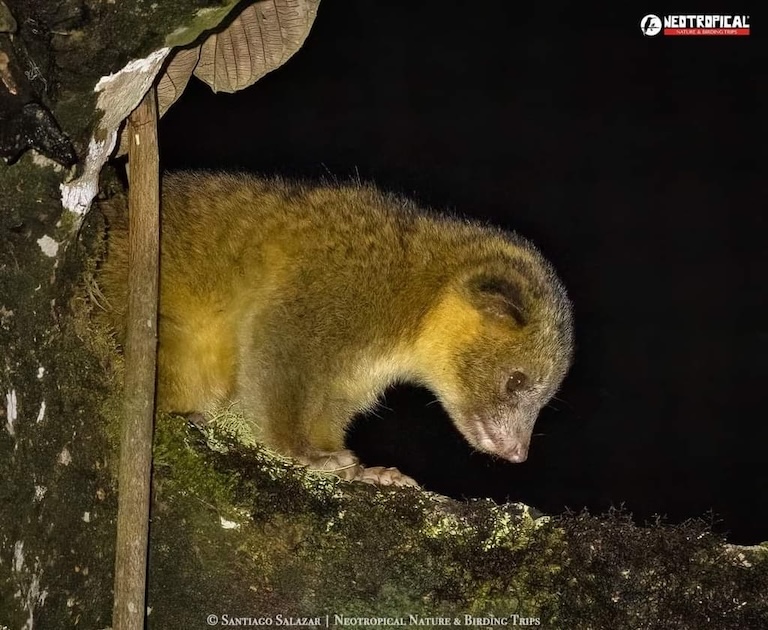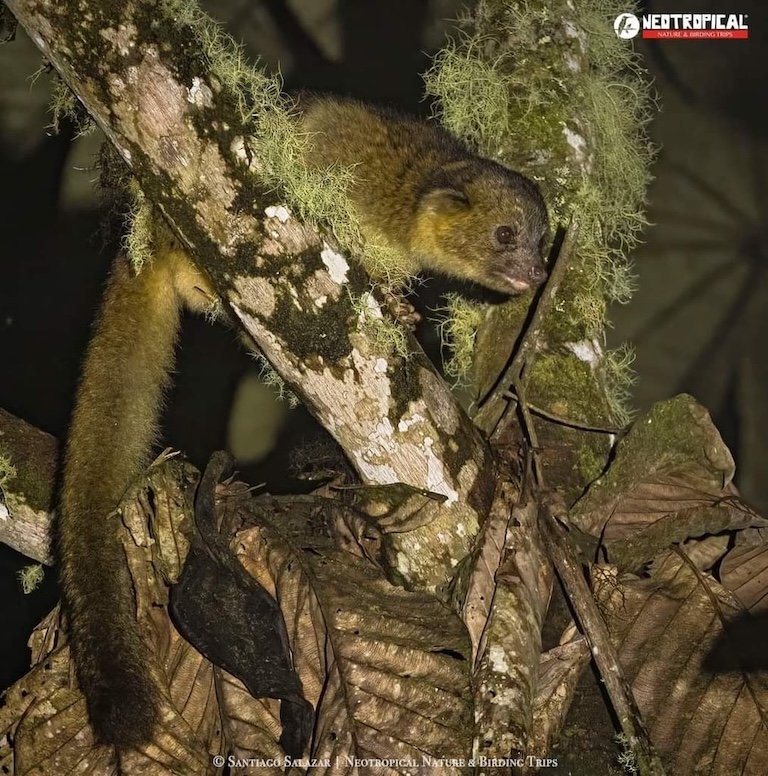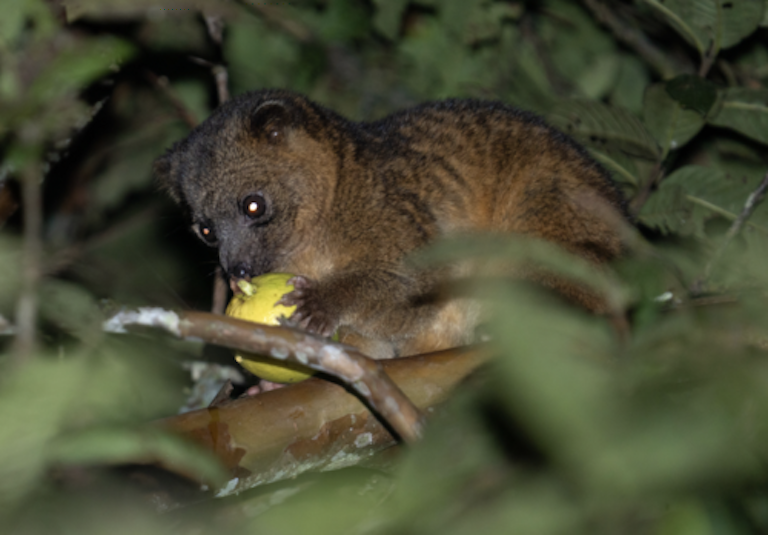Olinguito Profile
If you want to discover a new species, it’s likely going to be as easy as turning over a rock in your garden and investigating what you find under a microscope. The vast majority of animals have yet to be described, but this majority exists almost exclusively within the micro world; it’s very rare to discover anything new that’s bigger than, say, a sparrow.
It’s even rarer to discover a new large mammal, and even more rare to find a new carnivore that had been sitting up there in the trees all this time. So, the discovery of the olinguito in 2013 was a fresh treat. This is the first mammalian carnivore to be discovered in 35 years.

Olinguito Facts Overview
| Habitat: | Montane forest |
| Location: | Andes of Colombia and Ecuador |
| Lifespan: | Unknown |
| Size: | 3.5m |
| Weight: | 900g (2lb) |
| Colour: | Grey/brown, some are red, orange |
| Diet: | Mostly fruits, insects, nectar |
| Predators: | |
| Top Speed: | Unknown |
| No. of Species: | 1 |
| Conservation Status: | Near Threatened (IUCN) |
The olinguito was in fact known to science for quite a while, so to say it’s an entirely new discovery is a bit misleading, it just wasn’t identified as a new species until recently.
Still, it’s adorable and has reignited passion among researchers and taxonomists alike as a reminder that we still have a lot to learn about the ever-decreasing ecosystems we’re a part of.
Described as a cat/teddy bear hybrid, this small raccoon-like animal skulks about in the canopies of the Colombian Andes, apparently looking like something else.
Interesting Olinguito Facts
1. It’s almost an Olingo
But this is an olingo that was already an olingo before it was discovered to be a different olingo than the one people thought it was. When researchers looked closely, they discovered what had appeared to be a run-of-the-mill Bassaricyon gabbii was, in fact, a totally new species.
This species was subsequently named Bassaricyon neblina, or the Olinguito.
While olingo is the common name for members of its genus, the olinguito has been genetically determined to be a little more distant from the group than the other members (only sharing around 90% of its DNA with the closes olingo relative), making it more akin to a separate genus, and therefore likely to be redefined eventually. 1

2. It’s a fraud!
This is an animal that has been sitting in zoos and museums just as long as any other cloud forest carnivores from the region.
It’s even had its DNA sequenced. And all this time, people simply thought it was something else. So, this isn’t so much a new animal discovered, as a new distinction between two animals, once thought to be the same thing.
This mistake led to a presumably uncomfortable forced pairing between another species of olingo and the misidentified olinguito, which was, as you’d expect, unsuccessful. It was only in 2013 that scientists discovered why.
Does that count as a new species discovered? Technically. But it’s not nearly as exciting. This poor animal has gone from being paraded around as someone else to being paraded around as a brand new animal, even though it’s been hanging out with us for decades.
On the other hand, it’s a stark reminder of the diversity of “undiscovered” wildlife that’s still sitting in a dusty drawer somewhere in the cellar of Natural History Museums everywhere.
And once this little mammal was established to science, it began breaking all sorts of records. 2
3. It’s small
Olingos are in the Procyonidae family, with racoons and coatis. Of the lot of them, this olinguito is the most petite, at under 1kg in weight, and smaller than a house cat.
The genus differs from a lot of the others in the family in its preference for tree canopies, and while the kinkajou, another relative, also developed an arboreal lifestyle, this happened on a totally independent lineage than the olinguito.
While it’s small and arboreal, it appears to have the widest range of any of the genus, farther-reaching than its olingo cousins, spanning both longer distances and higher altitudes than its peers.
4. There are four of them
Once people knew what to look for, everyone was finding new varieties. So far, there are thought to be four subspecies of olinguito, coming in different colours.
Red, brown and orange olinguitos have already been found, and as taxonomists all over the world hurriedly dust the Pringles crumbs off their shirts and scramble out of their seats to get their name on an animal, we’ll likely see a few more come out over the coming years. 3
5. Blueberry poops
While it’s technically a true carnivore, being a member of the order of sharp-toothed killers, this is an opportunistic omnivore, with a penchant for fruit.
It eats more fruit than anything else – mostly figs – but it’s also partial to a bit of nectar and the occasional grub or passing insect. This is probably a good strategy for an animal that lives in perpetual fog, but it has drawn some odd comparisons.
It has been reported, and there’s no indication of why this was considered a good idea, that this small carnivore’s diet of insects, fruit, and nectar, gives its poo a blueberry quality. 4

6. It’s in decline
From the moment of its discovery, this was an animal in trouble. It lives in a threatened ecosystem, with already, 40% of this animal’s presumed range has been deforested, and another 21% is otherwise unforested.
As of now, the species looks to be Near Threatened, but its numbers are in decline and the threats to its habitat are still in full swing. 5
Olinguito Fact-File Summary
Scientific Classification
| Kingdom: | Animalia |
| Phylum: | Chordata |
| Class: | Mammalia |
| Order: | Carnivora |
| Family: | Procyonidae |
| Genus | Bassaricyon |
| Species: | Neblina |
Fact Sources & References
- Kristofer M. Helgen (2013), “Taxonomic revision of the olingos (Bassaricyon), with description of a new species, the Olinguito”, Zoo Keys.
- Author Name (Year), “Article Name”, Publication.
- Elizabeth Landau (2013), “Olinguito the newest rare mammal species discovery”, CNN.
- “Badass Nature’s Top Animal Discoveries of 2013”, Zoology and Botany.
- “Olinguito”, IUCN Red List.
